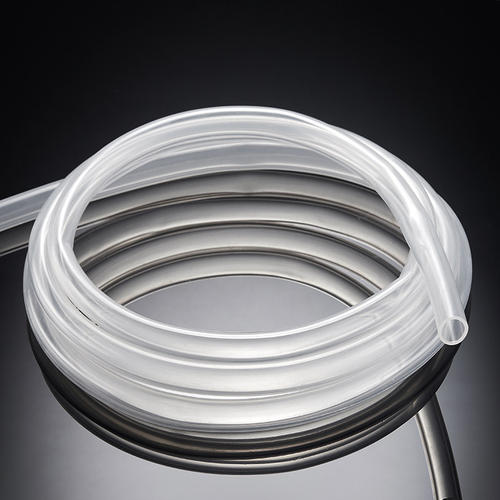Peristaltic pump transmits liquid through hose. The liquid only contacts the inner wall of the hose and will not contact the driver and pump head of the peristaltic pump, which can well maintain the cleanliness of the liquid. Silicone hose is the most commonly used hose of peristaltic pump. What are the characteristics about it? Let’s explore it together.
1.Peristaltic pump hose characteristics as below:
- The pump hose has certain elasticity, that is, the hose can quickly recover its shape after radial compression(Shore hardness: 40 ~ 80).
- It has certain wear resistance
- Have a certain ability to withstand pressure
- No leakage (good air tightness) and low adsorption
- Temperature resistance, not easy to aging
- Non swelling and corrosion resistance
- Low precipitate
2、 Chemical compatibility
When transporting different fluids, the hose should show certain excellent chemical properties, which is called chemical compatibility. Such as: low adsorption, good temperature resistance, not easy to aging, not swelling, corrosion resistance, low precipitates. Ordinary pipes only have general contact with chemicals, while peristaltic pump pipes are in contact with chemical fluids under working conditions. Therefore, the chemical compatibility level of ordinary pipes and peristaltic pump pipes cannot be the same. For various transmission solutions, peristaltic pumps have hoses of corresponding materials to meet the needs. The user shall check each chemical substance in the solution to ensure that it is compatible with the selected pump pipe.
Chemical compatibility test: take a section of sample tube, record its weight, diameter, length and other parameters, immerse the sample tube in a closed container containing liquid for at least 48 hours, take out the sample tube, wash and dry it with clean water, re measure its weight, diameter and length, and observe the changes; At the same time, check whether the hose becomes soft or brittle. If there is any change, it indicates that the hose is chemically affected by the liquid, that is, the hose is incompatible with the liquid. Each candidate pump pipe sample shall be put into the actual environmental conditions of the factory for trial operation, and the test results shall be closely observed. If the pump pipe does not show discoloration, swelling, cracks, loss of fluidity, or other signs of deterioration after commissioning, it is proved to be compatible with the fluid.
3、 Pressure bearing
Back pressure occurs when a pump pushes fluid through a filter, or through a flow meter or valve, or pumps fluid into a pressurized reaction vessel. The application of peristaltic pump is limited by the pressure bearing performance of hose. If the system pressure exceeds the limit pressure of the hose, the hose will expand, resulting in excessive wear or rupture of the hose. The factors affecting the pressure of hose include: material, the ratio of diameter to wall thickness, etc.
4、 Temperature
The adaptability of the hose to the working temperature range is a factor to be considered by the user. Different materials have different temperature performance. Some pipes, such as silicone rubber, have a wide temperature tolerance range and are suitable for high-temperature and low-temperature processes; Some pipes are only suitable for a small temperature range. Before selecting pipes, users should first understand the high temperature and low temperature in the system, and then ensure that the selected pump pipes work safely in this temperature range.
5、 Dimensions
The size of the hose directly affects the flow. The inner diameter of the hose determines the flow, and the inner diameter is directly proportional to the flow. The wall thickness affects the ability of the hose to be compressed and rebound, and also has a great impact on the service life of the hose.
6、 Transparency
Whether a transparent pipe should be used depends on whether the operator needs to observe the condition of the fluid in the pipe at any time and whether the fluid is sensitive to light. If the operator needs to observe the fluid, bubbles, particles, pollution, etc. in the pipe at any time, transparent pipes such as Tygon polyethylene or silicone rubber shall be selected; If the solution is not suitable for exposure, opaque pipes should be selected.
7、 Breathability
For some gas sensitive fluids, such as those susceptible to oxidation or anaerobic cell culture medium, users should consider the permeability of the pipeline. Generally speaking, silicone hose has high air permeability. Therefore, for fluids that are not suitable for contact with gas, pipes with low air permeability should be selected.
8、 Authentication
The hose may be subject to relevant certification when used for relevant purposes. Such as USP, EP, FDA, USDA and NSF.
9、 Hose life
Different hoses have different resistance to repeated extrusion and friction of rollers. Different pipe types, pipes, pump heads and operating speeds have different service lives. Long life, thick wall pipe and large flow pump are selected, and longer service life of hose can be obtained when running at low speed.
10、 Flow range
Each hose corresponds to a fixed speed range, and we select the corresponding hose according to the flow range required by customers.
Lead Fluid technology Co.,Ltd is the professional peristaltic pump manufacturer with 20 years experience, we have different types of silicone hose and other materials of peristaltic pump hose.
If you need the hose and peristaltic pump, welcome to connect us.
Email:master@leadfluid.com
Tel:86+15612256761,86+15612256251,86+13313247660
Web:www.leadfluid.com

